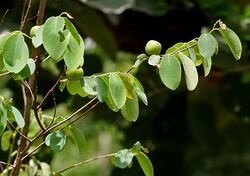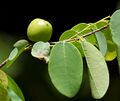Biology:Cleistanthus collinus
| Cleistanthus collinus | |
|---|---|

| |
| Scientific classification | |
| Kingdom: | Plantae |
| Clade: | Tracheophytes |
| Clade: | Angiosperms |
| Clade: | Eudicots |
| Clade: | Rosids |
| Order: | Malpighiales |
| Family: | Phyllanthaceae |
| Genus: | Cleistanthus |
| Species: | C. collinus
|
| Binomial name | |
| Cleistanthus collinus (Roxb.) Benth. ex Hook.f.
| |
| Synonyms | |
|
Lebidieropsis orbiculata var. lambertii | |
Cleistanthus collinus[2] is a plant species first described by Roxburgh, with its current name after Bentham and Hooker; it is included in the family Phyllanthaceae.[3][4] The IUCN categorizes this species as vulnerable.[1] No subspecies are listed in the Catalogue of Life.[3]
Properties
Cleistanthus collinus (Karra) contains a plant poison also called oduvan (Tamil), kadise (Kannada), Vadisaku (Telugu), Oduku (Malayalam) and Gaja Madara (Sinhala) . Ingestion of its leaves or a decoction of its leaves causes hypokalemia (kaliuresis and cardiac arrhythmias),[5] metabolic acidosis, hypotension and hypoxia[6] probably due to distal renal tubular acidosis, ARDS and toxin induced vasodilatation respectively.[7][8][9] Hypokalemia and acidosis probably also induces rhabdomyolysis resulting in myoglobinuric kidney failure and neuromuscular weakness.[10] Its effects are probably mediated by injury to the distal renal tubules, pulmonary epithelium and peripheral blood vessels due to glutathione depletion[11] (animal studies have shown benefit with N-acetylcysteine).[12]
Gallery
-
Karra at fruiting
References
- ↑ 1.0 1.1 World Conservation Monitoring Centre (1998). "Cleistanthus collinus". IUCN Red List of Threatened Species 1998: e.T34271A9855293. doi:10.2305/IUCN.UK.1998.RLTS.T34271A9855293.en. https://www.iucnredlist.org/species/34271/9855293.
- ↑ Benth. ex Hook.f., 1887 In: Fl. Brit. India 5: 274
- ↑ 3.0 3.1 Roskov Y.; Kunze T. (2014). "Species 2000 & ITIS Catalogue of Life: 2014 Annual Checklist.". in Didžiulis V.. Species 2000: Reading, UK.. http://www.catalogueoflife.org/annual-checklist/2014/details/species/id/9789137.
- ↑ WCSP: World Checklist of Selected Plant Families
- ↑ Thomas, K; Dayal, AK; Narasimhan, Alka G; Seshadri, MS; Cherian, AM; Kanakasabapathi, Molly B (1991). "Metabolic and Cardiac effects of Cleistanthus Collinus poisoning". J Assoc Physicians India 39 (4): 312–314. PMID 1938816.
- ↑ Subrahmanyam, DK; Mooney, T; Raveendran, R; Zachariah, B. A (Nov 2003). "Clinical and laboratory profile of Cleistanthus collinus poisoning". J Assoc Physicians India 51: 1052–4. PMID 15260387.
- ↑ Eswarappa, S.; Chakraborty, A R; Palatty, B U; Vasnik, M (2003). "Cleistanthus Collinus Poisoning: Case Reports and Review of the Literature". Clinical Toxicology 41 (4): 369–72. doi:10.1081/clt-120022005. PMID 12870879.
- ↑ Benjamin SPE, M Edwin Fernando, JJ Jayanth, Preetha B; Cleistanthus collinus poisoning. J Assoc Physicians India 2006 Sep; 54:742-44
- ↑ Nampoothiri, K; Chrispal, A; Begum, A; Jasmine, S; Gopinath, KG; Zachariah, A (Mar 2010). "A clinical study of renal tubular dysfunction in Cleistanthus collinus (Oduvanthalai) poisoning". Clin Toxicol 48 (3): 193–7. doi:10.3109/15563651003641786. PMID 20397801.
- ↑ Eswarappa, Benjamin SPE (Jan 2007). "Renal failure and neuromuscular weakness in Cleistanthus collinus poisoning". J Assoc Physicians India 55: 85–86. PMID 17447300.
- ↑ Sarathchandra, G; Balakrishnamoorthy, P. "Acute toxicity of Cleistanthus collinus, an indigenous poisonous plant in Cavia procellus". Journal of Environmental Biology 1998: 145–8.
- ↑ Annapoorani, KS; Damodaran, C; Chandrasekharan, P (1986). "A promising antidote to Cleistanthus collinus poisoning". J Sci Soc Ind 2: 3–6.
Wikidata ☰ Q13110806 entry
 |





